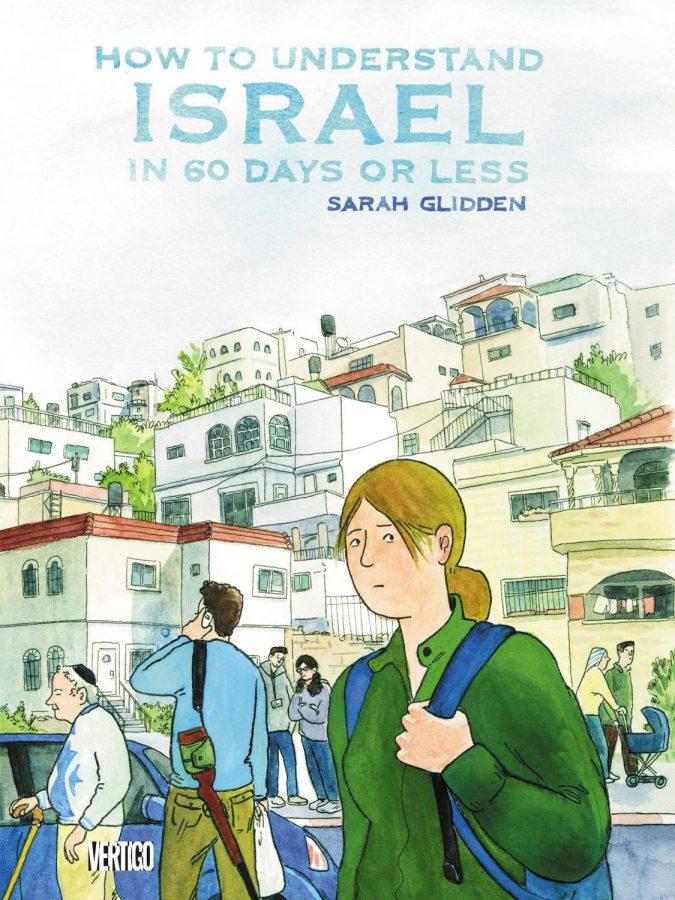Readers can find two new graphic novels with Jewish twists
Published June 22, 2011
“I’m Jewish so that means I’m supposed to support Israel…right? [But] I’m left-wing and progressive. [So I’m] supposed to be anti-Israel…So see? I’m stuck!” That talk between “Sarah,” comics-artist, Sarah Glidden, and Nadan, a counselor on her 2007 Birthright Israel tour, is one of several confessional conversations in Glidden’s graphic (comic-book format) memoir “How to Understand Israel in 60 Days or Less (Vertigo-DC Comics, 208 pp., $24.99).
Many readers will have heard about Birthright Israel (Taglit) which hosts Jewish young people, aged 18-26, on all-expense-paid, novice trips to Israel. (Birthright takes credit for having brought nearly 300,000 Jewish, young adults to Israel, from 54 countries, since the program’s inception in 1999.) In preparation for her trip, Glidden immersed herself, for some 40 days prior, in books about Jews and Israel. The period of study plus the dozen-or-so days spent in Israel accounts for the “60 days” in the title.
ADVERTISEMENT
“Maus” by Art Spiegleman is the inventive, comic-book history of the Holocaust portrayed as a parable of (Jewish) mice and (Nazi) cats. When Parts I and II were published in 1986 and 1991 — for me and probably for other Boomer-generation readers — that was a landmark introduction to cartoon history and comics art, for grown-ups. Glidden carries on the tradition of comics for adults in the genre of “comics journalism,” where she has found the perfect meeting of “art and ideas.”
The author has nicely structured her memoir as a story in which the trip to Israel unfolds in the present tense. She is a reflective, first-person narrator, and also an anonymous-looking character who engages in dialogue with other characters. To good effect, Glidden uses images to represent the current moment, flashbacks, ghost images of deceased personalities and fantasy—as when, to express her ignorance about battlefields, she humorously portrays soldiers on dinosaurs.
Glidden confesses, “I had always resisted Birthright, because I thought those tours were just propaganda.” But then her mother urged her to visit Israel for a first-hand look. The memoir portrays a classic visit to Israel (the Golan Heights, Yad Vashem, the Dead Sea, Masada, Jerusalem, the Western Wall, etc.) starting with Israeli security routines at the airport. Did you become a bat mitzvah?/Yes. What was your portion?/Maybe from the Book of Ruth. How many guests?/ Just family—and no DJ!
Despite the title, “How to Understand Israel…”, the book does not even begin to undertake an in-depth discussion of the Arab-Israeli conflict. The point of the narrative is Sarah’s passage from guilty disapproval of the Jewish state to a recognition of the complexity in the Arab-Israeli conflict and her deeply-felt connection to Israel and its people. I gave no spoiler alert, because it’s the journey not the destination that creates the charm, humor and substance of the book. The book will be especially engaging (except for the occasional expletive) for middle and high school students and young adults eligible for Birthright Israel.
ADVERTISEMENT
Another recent, graphic adaptation of a subject with Jewish interest is by veteran comics artist, Ernie Colón, 80, and comics writer/editor, Sid Jacobson, 82. Throughout long and productive careers, Colón and Jacobson have collaborated at Harvey, Marvel and DC Comics. Among the comics series for which they earned their reputation are those featuring Caspar the Ghost and the fictional, Richie Rich. They collaborated on “The 9/11 Report: A Graphic Adaptation” (2006) and after that on a graphic biography of Che Guevara (2009). On account of those books, they were tapped by Amsterdam’s Anne Frank House to create “Anne Frank: The Anne Frank House Authorized Graphic Biography” (Hill and Wang, 152 pp., $16.95).
For an intelligent, thorough history of Hitler’s “most famous victim,” I would be remiss if I didn’t mention the documentary, “Anne Frank Remembered” (1995). That film features a number of uniquely, informative personalities, especially one of the Franks’ rescuers, Miep Gies, and the dentist’s son, Peter Pfeffer, (both, since then, deceased). The film also includes several, riveting seconds of the only known motion picture footage of Anne Frank—at an upper story window as she watches a wedding party on the street below.
But middle, high school and other readers are likely to be well-served by this graphic biography of Anne Frank. The weakly scripted dialogue would not have been missed if left out altogether. But the Frank-family’s experience during the Nazi era, including Anne’s death at Bergen-Belsen, is fairly well and simply represented through third-person narration.
For several generations of audiences, the movie and stage adaptations of Anne’s diary placed undue importance, on squabbling amongst the Jews hiding in the annex; Shelley Winters won a Best Supporting Oscar for her 1959 portrayal of Mrs. Van Pels as a disturbingly, petulant and disfunctional personality. But Colón’s and Jacobson’s book, which “draw[s] on the expert authority of the Anne Frank House” reloads the perspective: Of eight people hiding in the annex only Anne’s father, Otto survived; the villains in the Anne Frank story are those who persecuted her and the millions European Jews.
















